初中英语量词用法大全
初中英语语法知识之数量词
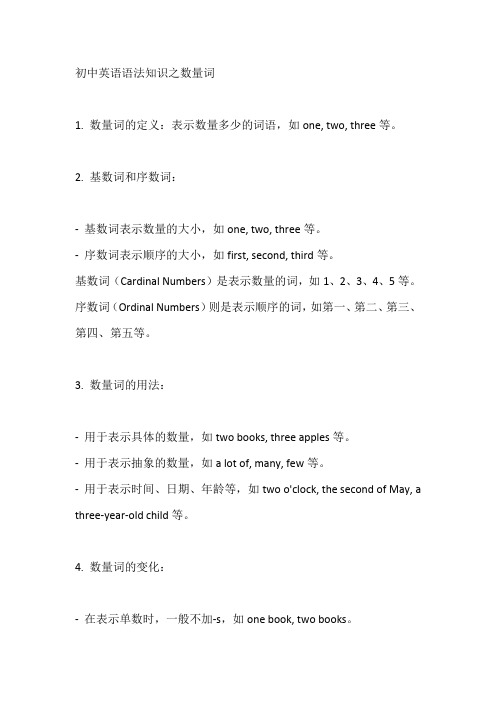
初中英语语法知识之数量词1. 数量词的定义:表示数量多少的词语,如one, two, three等。
2. 基数词和序数词:- 基数词表示数量的大小,如one, two, three等。
- 序数词表示顺序的大小,如first, second, third等。
基数词(Cardinal Numbers)是表示数量的词,如1、2、3、4、5等。
序数词(Ordinal Numbers)则是表示顺序的词,如第一、第二、第三、第四、第五等。
3. 数量词的用法:- 用于表示具体的数量,如two books, three apples等。
- 用于表示抽象的数量,如a lot of, many, few等。
- 用于表示时间、日期、年龄等,如two o'clock, the second of May, a three-year-old child等。
4. 数量词的变化:- 在表示单数时,一般不加-s,如one book, two books。
- 在表示复数时,一般加-s,如two books, three apples。
- 在表示序数时,一般加-th,如fourth, fifth。
- 在表示百分数时,一般加-percent,如50%。
5. 特殊的数量词:- a/an:表示“一个”,但只用于单数可数名词前。
- some:表示“一些”,用于肯定句中。
- any:表示“任何”,用于否定句和疑问句中。
- much:表示“许多”,用于不可数名词前。
- many:表示“许多”,用于可数名词前。
- several:表示“几个”,用于可数名词前。
英语量词用法大全,收藏起来慢慢学习吧

英语量词用法大全,收藏起来慢慢学习吧常用语法场景1:当和外国友人走在公园,突然看到一群鸽子。
这时候你是不是就会说:There are many pigeons 或者a lot of呢?想再高大上一点吗?Sam, look! There is a flock of pigeons over there.场景2:当说三张纸的时候,是不是很习惯说:three papers?错了哦。
paper是不可数名词。
正确说法是:three pieces of paper。
◆◆量词用法整理+讲解◆◆量词可以用于描述可数名词比如a herd of elephants(一群大象), 也可以描述不可数名词;比如three pieces of paper。
1、描述一群...量词+群+of+名词一群人a/an crowd/group/army/team/of people;一群牛、象、马、天鹅a herd of cattle/elephants/horses/swans一群鸟、鹅、母鸡、羊、燕子a flock of birds/geese/hens/goats/swallows一群猎狗、狼a pack of hounds/wolves2、描述一丝/点/层一丝怀疑a shadow of doubt一线未来之光a glimpse of future一缕月光a streak of moonlight一层霜/雪/糖霜a layer of frost/snow/cream3. piece块;片;段;项;件;篇;首;幅;张a piece of bread/paper/wood/furniture/land/advice/news/meat /cloth/music...4、英译一阵一阵哭泣/喝彩/炮击/雷声a burst of tears/cheers/gunfire/thunder一阵泪雨/瓢泼大雨/夸夸其谈a flood of tears/rain/boasts5. A pair of 在英语需要成双成对的表达:a pair of glassesa pair of scissorsa pair of spectaclesa pair of trousersa pair of pantsa pair of pliers6、最常用英语量词用法例举a drop of water 一滴水a flood of moonlight 一片月光a flood of light 一大片强光a flood of people人潮如涌a flood of words口若悬河a flood of tears泪如泉涌a wisp of smoke 一缕烟/一股烟a wisp of a smile 一丝微笑a pane of glass 一块玻璃a layer of rock 一层岩石a cloud of smoke 一团烟雾a beam of light 一束光线a blade of grass 一片草叶a block of wood 一块木头a cube of sugar 一块方糖a roll of newspaper 一卷报纸a cone of ice cream 一个蛋卷冰淇淋a bar of chocolate 一块巧克力a stack of hay 一堆乾草a loaf of bread 一个面包a grain of rice 一粒米a cake of soap 一块肥皂a dash of salt 一撮盐a coil of wire 一卷电线a roll of tobacco一卷烟草a roll of bread 一块面包a ball of wool 一个毛线球a glimmer of hope 一线希望a thread of hope一线希望a thread of smoke一缕青烟a piece of such cord一根细丝a thread of water细细的一条流水a mouthful of sweet country air一口新鲜的乡村空气a handful of corn 一把玉米a handful of people 少数几个人a group of people。
英语量词总结

英语量词总结1. 一、量词量词是用来表示人、物的数量的词或词组。
它们既可以单独使用,也可以与名词搭配使用,起着定语或宾语的作用。
1) 数量词数量词用来表示数目,其特点是后面跟着名词。
这类量词有:a. 不可数名词:a piece of, a bit of, a slice of 等b. 可数名词: a bottle of, a bag of, a loaf of, a pair of 等2) 基数词基数词用来表示抽象的数目,即一个一个地数数的数目。
如:one, two, three, four, five, six, seven, eight, nine, ten。
3) 序数词序数词表示某一个物体在一组物品中的先后次序。
如:first, second, third, fourth, fifth, sixth, seventh, eighth, ninth, tenth。
2. 二、分数、比率与百分数分数、比率与百分数用来表示一部分与整体的比例。
1) 分数分数表示一部分与其所属整体的比例,由若干部分中的一部分和所属整体组成,用符号/或÷连接。
如:One half(1/2) Eight sevenths (8/7) Two thirds(2/3)2) 比率比率是指两种或两种以上的量,表示其中一部分与其余各部分之间的比例的量。
它以a:b或a/b的形式来表示,其中,a和b可以是数字,单词或短语。
如:Four:nine (4:9) Two-thirds:one-third (2/3:1/3) Books:pens (books:pens)3) 百分数百分数是指用百分率表示法来表示一部分与整体的比例,它由百分符号“%”和基数词组成。
英语中量词的总结归纳
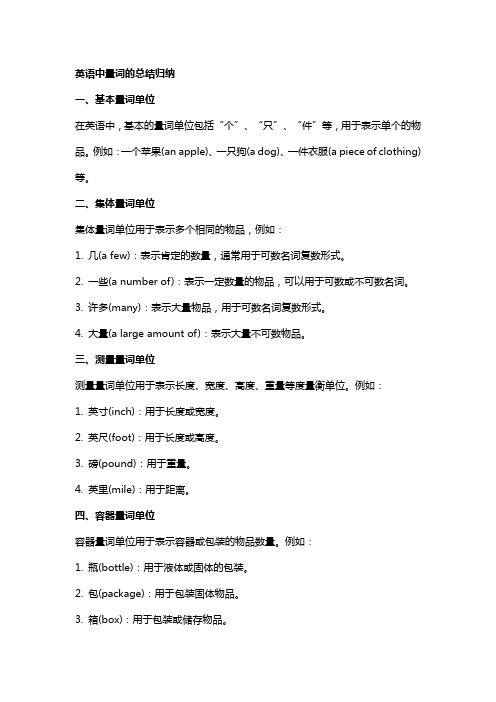
英语中量词的总结归纳一、基本量词单位在英语中,基本的量词单位包括“个”、“只”、“件”等,用于表示单个的物品。
例如:一个苹果(an apple)、一只狗(a dog)、一件衣服(a piece of clothing)等。
二、集体量词单位集体量词单位用于表示多个相同的物品,例如:1. 几(a few):表示肯定的数量,通常用于可数名词复数形式。
2. 一些(a number of):表示一定数量的物品,可以用于可数或不可数名词。
3. 许多(many):表示大量物品,用于可数名词复数形式。
4. 大量(a large amount of):表示大量不可数物品。
三、测量量词单位测量量词单位用于表示长度、宽度、高度、重量等度量衡单位。
例如:1. 英寸(inch):用于长度或宽度。
2. 英尺(foot):用于长度或高度。
3. 磅(pound):用于重量。
4. 英里(mile):用于距离。
四、容器量词单位容器量词单位用于表示容器或包装的物品数量。
例如:1. 瓶(bottle):用于液体或固体的包装。
2. 包(package):用于包装固体物品。
3. 箱(box):用于包装或储存物品。
4. 桶(bucket):用于液体或固体的储存或包装。
五、抽象量词单位抽象量词单位用于表示抽象的概念或属性。
例如:1. 种(kind):表示种类,用于描述不同的事物。
2. 点(point):表示小的数量或程度,常用于描述优点、缺点等。
3. 片(piece):用于描述部分的数量,通常与不可数名词连用。
英语量词用法大全,收藏起来慢慢学习吧

英语量词用法大全,收藏起来慢慢学习吧!常用语法场景1:当和外国友人走在公园,突然看到一群鸽子。
这时候你是不是就会说:There are many pigeons 或者a lot of呢?想再高大上一点吗?Sam, look! There is a flock of pigeons over there.场景2:当说三张纸的时候,是不是很习惯说:“three papers”?错了哦。
paper是不可数名词。
正确说法是:three pieces of paper。
◆◆量词用法整理+讲解◆◆量词可以用于描述可数名词比如a herd of elephants(一群大象), 也可以描述不可数名词;比如three pieces of paper(三张纸)1、描述一群...量词+群+of+名词一群人 a/an crowd/group/army/team/of people;一群牛、象、马、天鹅 a herd of cattle/elephants/horses/swans 一群鸟、鹅、母鸡、羊、燕子a flock of birds/geese/hens/goats/swallows一群猎狗、狼 a pack of hounds/wolves2、描述一丝/点/层一丝怀疑 a shadow of doubt一线未来之光 a glimpse of future一缕月光 a streak of moonlight一层霜/雪/糖霜 a layer of frost/snow/cream3. piece块;片;段;项;件;篇;首;幅;张a piece of bread/paper/wood/furniture/land/advice/news/meat/cloth/music...4、英译“一阵”一阵哭泣/喝彩/炮击/雷声a burst of tears/cheers/gunfire/thunder一阵泪雨/瓢泼大雨/夸夸其谈a flood of tears/rain/boasts5. A pair of 在英语需要成双成对的表达:a pair of glasses (一副眼镜)a pair of scissors (一把剪刀)a pair of spectacles (一副眼镜)a pair of trousers (一条裤子)a pair of pants (一条裤子)a pair of pliers(一把剪钳)6、最常用英语量词用法例举a drop of water 一滴水a flood of moonlight 一片月光a flood of light 一大片强光a flood of people人潮如涌a flood of words口若悬河a flood of tears泪如泉涌a wisp of smoke 一缕烟/一股烟a wisp of a smile 一丝微笑a pane of glass 一块玻璃a layer of rock 一层岩石a cloud of smoke 一团烟雾a beam of light 一束光线a blade of grass 一片草叶a block of wood 一块木头a cube of sugar 一块方糖a roll of newspaper 一卷报纸a cone of icecream 一个蛋卷冰淇淋a bar of chocolate 一块巧克力a stack of hay 一堆乾草a loaf of bread 一个面包a grain of rice 一粒米a cake of soap 一块肥皂a dash of salt 一撮盐a coil of wire 一卷电线a roll of tobacco一卷烟草a roll of bread 一块面包a ball of wool 一个毛线球a glimmer of hope 一线希望a thread of hope一线希望a thread of smoke一缕青烟a piece of such cord一根细丝a thread of water细细的一条流水a mouthful of sweet country air一口新鲜的乡村空气a handful of corn 一把玉米a handful of people 少数几个人a group of people [trees, houses]一群人[一片树林, 一片房子] an army of elephants 一群大象a pack / throng of wolves 一群狼a batch of dogs 一群狗a brood of chicks 一群小鸡a hive of bees 一群蜜蜂a host of monkeys 一群猴子a school of fish 一群鱼a swarm of locusts 一群蝗虫a team / field of horses一群马a gang of elks 一群驼鹿a burst of laughter 一阵笑声a gust of wind 一股风a web of railroad 铁路网a train of thoughts 一连串的想法a nice cup of tea 一杯好茶a thin coat of ice 一层薄冰a stagnant pool of water 一潭死水a beautiful stretch of field 一片美丽的原野a pair of glasses 一副眼镜a pair of scissors 一把剪刀a pair of pliers一把钳子a pair of spectacles 一副眼镜a pair of trousers 一条裤子a pair of shoes一双鞋a pair of pant 一条裤子a pair of dancers一对舞伴a pair of stairs一段楼梯a pair of pliers 一把剪钳a piece of paper 一张纸a piece of information 一条消息an article of clothes 一件衣物a cup of water 一杯水a packet of cigarettes 一盒香烟a basket of vegetables 一篮子蔬菜。
常用的英文量词
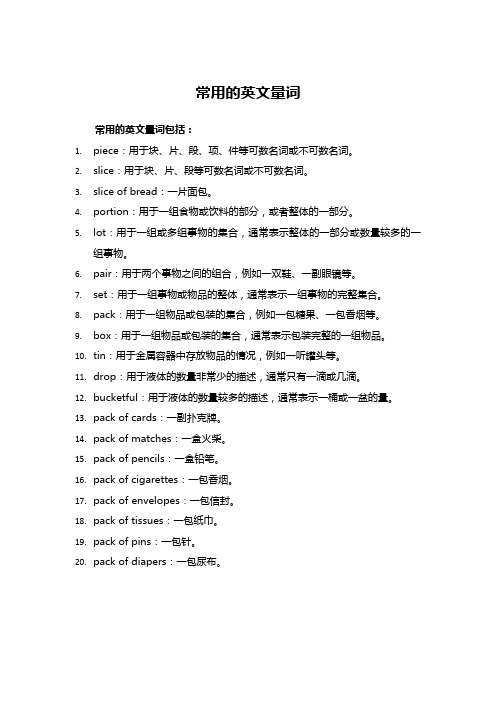
常用的英文量词
常用的英文量词包括:
1.piece:用于块、片、段、项、件等可数名词或不可数名词。
2.slice:用于块、片、段等可数名词或不可数名词。
3.slice of bread:一片面包。
4.portion:用于一组食物或饮料的部分,或者整体的一部分。
5.lot:用于一组或多组事物的集合,通常表示整体的一部分或数量较多的一
组事物。
6.pair:用于两个事物之间的组合,例如一双鞋、一副眼镜等。
7.set:用于一组事物或物品的整体,通常表示一组事物的完整集合。
8.pack:用于一组物品或包装的集合,例如一包糖果、一包香烟等。
9.box:用于一组物品或包装的集合,通常表示包装完整的一组物品。
10.tin:用于金属容器中存放物品的情况,例如一听罐头等。
11.drop:用于液体的数量非常少的描述,通常只有一滴或几滴。
12.bucketful:用于液体的数量较多的描述,通常表示一桶或一盆的量。
13.pack of cards:一副扑克牌。
14.pack of matches:一盒火柴。
15.pack of pencils:一盒铅笔。
16.pack of cigarettes:一包香烟。
17.pack of envelopes:一包信封。
18.pack of tissues:一包纸巾。
19.pack of pins:一包针。
20.pack of diapers:一包尿布。
初中英语量词运用
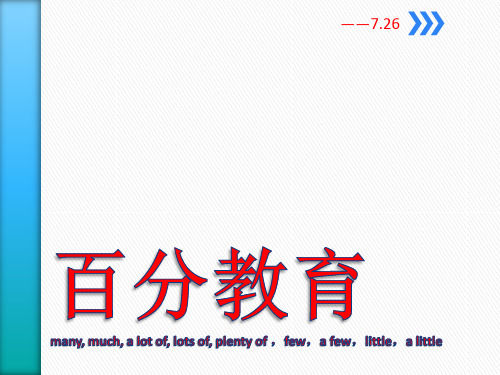
» many / much 既可作限定词,也可作不定代 词(INDEFINITE PRONOUN〕,a lot 也可单独 用作名词词组: Have you done all these exercises? ----No, I haven't done very many. Have you done much work today? ----Yes, I've done a lot (work).
» 要注意,quite a few, a good few. not a few不表 示"少",而表示"相当多"的含义,相当于, a fair number (of)。例如: » Quite a few of us are getting worried. » 我们相当多的人正在担心。 » You'll have to wait a good few weeks. » 你将不得不等上相当多个星期。
» c) 用于在句首作主语以及在"存在句"中作实 义主语的名词词组中。例如: » Many people like going abroad to have their holidays. » 许多人喜欢去国外渡假。 » Much coal has been saved through the use of the new device. » 通过用新的装置,很多煤被节省下来。 » There are many girl students in my class. » 在我的班级里有许多女学生。
» You can take as many copies(copy) as you need. » 你可以根据你的需要想拿多少张就拿多少张。 » You can use as much oil as you need. » 根据你的需要想用多少油就用多少。 » We've had too much rain this spring. » 这个春天我们已经有太多的雨。 » You can eat as much as you want. » 你可以根据你想吃多少就吃多少。
英语量词用法大全 收藏起来慢慢学习吧

英语量词用法大全收藏起来慢慢学习吧!常用语法场景1:当和外国友人走在公园,突然看到一群鸽子。
这时候你是不是就会说:There are many pigeons 或者a lot of呢?想再高大上一点吗?Sam, look! There is a flock of pigeons over there.场景2:当说三张纸的时候,是不是很习惯说:“three papers”?错了哦。
paper是不可数名词。
正确说法是:three pieces of paper。
◆◆量词用法整理+讲解◆◆量词可以用于描述可数名词比如a herd of elephants(一群大象), 也可以描述不可数名词;比如three pieces of paper(三张纸).1、描述一群...量词+群+of+名词一群人 a/an crowd/group/army/team/of people;一群牛、象、马、天鹅 a herd of cattle/elephants/horses/swans一群鸟、鹅、母鸡、羊、燕子a flock of birds/geese/hens/goats/swallows一群猎狗、狼 a pack of hounds /wolves2、描述一丝/点/层一丝怀疑 a shadow of doubt一线未来之光 a glimpse of future一缕月光 a streak of moonlight一层霜/雪/糖霜 a layer of frost/snow/cream3. piece块;片;段;项;件;篇;首;幅;张a piece of bread/paper/wood/furniture/land/advice/news/meat/cloth/music...4、英译“一阵”一阵哭泣/喝彩/炮击/雷声a burst of tears/cheers/gunfire/thunder一阵泪雨/瓢泼大雨/夸夸其谈a flood of tears/rain/boasts5. A pair of 在英语需要成双成对的表达:a pair of glasses (一副眼镜)a pair of scissors (一把剪刀)a pair of spectacles (一副眼镜)a pair of trousers (一条裤子)a pair of pants (一条裤子)a pair of pliers(一把剪钳)。
英语中量词的使用学起来

英语中量词的使用学起来
量词:(使用数量词表示事物的数量。
数量词通常位于所修饰的名词之前。
)
1、使用 most + 名词表示事物的大多数或几乎全部。
Most people enjoy parties.大多数人喜欢派对。
2、使用 many 和 a lot of 搭配名词表示事物的很大数量。
Many people like watching sports.许多人喜欢观看体育运动。
A lot of Canadians love watching ice hockey.很多加拿大人爱看冰上曲棍球赛。
3、使用 some 搭配名词表示事物不确切或模糊的数量。
Some people enjoy playing the guitar.许多人喜欢弹吉他。
4、使用 few 和 not many 搭配名词表示事物的少量。
Few people hate sports. 讨厌运动的人很少。
Not many people like walking in the rain. 喜欢在雨中漫步的人不多。
量词总结英文

量词总结英文1. 引言在英语中,量词是描述或表示物体数量或程度的词语。
量词在日常生活和学术领域中都扮演着重要角色。
本文将总结一些常见的英文量词,并提供一些例句来帮助读者更好地理解和使用这些量词。
2. 英文量词总结以下是一些常见的英文量词和它们的用法:•a/an:用于表示一个物体或人。
–Example: I saw a cat on the street.•some:表示不确定数量的物体或人。
–Example: Can you buy some apples at the grocery store?•few:表示不多的数量。
–Example: There are a few books on the shelf.•several:表示大约几个或几个以上的数量。
–Example: I have several friends coming to the party.•many:表示很多的数量。
–Example: There are many people in the park.•much:表示大量的数量。
–Example: She has much experience in this field.• a lot of:表示大量或许多的数量。
–Example: There are a lot of books on the table.•enough:表示足够的数量。
–Example: I have enough money to buy a new car.•little:表示很少的数量。
–Example: I have little time to finish the project.• a little:表示一些数量,但不是很多。
–Example: Can you give me a little help with this problem?•none:表示没有数量或零个。
–Example: There is none left in the fridge.•no:表示没有或没有具体数目。
中学英语数量词用法汇总

中学英语数量词用法汇总一、数词的分类1. 基数词表示数目的词称为基数词。
其形式如下:A.从1——1one,two,three,four,five,six,seven,eight,nine,ten.B.从11——19eleven,twelve,thirteen,fourteen,fifteen,sixteen,seventeen,eighteen,nineteen.这里除eleven,twelve,thirteen,fifteen,eighteen为特殊形式外,fourteen,sixteen,seventeen,nineteen 都是由其个位数形式后添加后缀-teen构成。
C.从21——9整数几十中除twenty,thirty, forty,fifty,eighty为特殊形式外,sixty,seventy,ninety都是其个位数形式后添加后缀-ty构成。
表示几十几时,在几十和个位基数词形式之间添加连字符“-” 21 twenty-one 76 seventy-sixD.百位数个数基数词形式加“hundred”,表示几百,在几十几与百位间加上and.101 a hundred and one320 three hundred and twenty648 six hundred and forty-eightE.千位数以上从数字的右端向左端数起,每三位数加一个逗号“,”。
从右开始,第一个“,”前的数字后添加thousand,第二个“,”前面的数字后添加million,第三个“,”前的数字后添加billion。
然后一节一节分别表示,两个逗号之间最大的数为百位数形式。
2,648 two thousand six hundred andforty-eight16,250,064 sixteen million two hundred and fifty thousand sixty-four5,237,166,234 five billion,two hundred and thirty-seven million,one hundred and sixty-six thousand,two hundred and thirty-fourF.基数词在表示确切的数字时,不能使用百、千、百万、十亿的复数形式;但是,当基数词表示不确切数字,如成百、成千上万,三三两两时,基数词则以复数形式出现。
【初中英语】【量词】用法整理

初中英语【量词】用法整理1、描述一群...量词+群+of+名词一群人:a/an crowd/group/army/team/of people;一群牛、象、马、天鹅:a herd of cattle/elephants/horses/swans一群鸟、鹅、母鸡、羊、燕子:a flock of birds/geese/hens/goats/swallows一群猎狗、狼:a pack of hounds/wolves2、描述一丝/点/层一丝怀疑 a shadow of doubt一线未来之光 a glimpse of future一缕月光 a streak of moonlight一层霜/雪/糖霜 a layer of frost/snow/cream3、piece 块;片;段;项;件;篇;首;幅;张a piece of bread/paper/wood/furniture/land/advice/news/meat/cloth/music...4、英译“一阵”一阵哭泣/喝彩/炮击/雷声:a burst of tears/cheers/gunfire/thunder一阵泪雨/瓢泼大雨/夸夸其谈:a flood of tears/rain/boasts:5、A pair of 在英语需要成双成对的表达:a pair of glasses(一副眼镜)a pair of scissors(一把剪刀)a pair of spectacles(一副眼镜)a pair of trousers(一条裤子)a pair of pants(一条裤子)a pair of pliers(一把剪钳)6、最常用英语量词用法例举a drop of water 一滴水a flood of moonlight 一片月光a flood of light 一大片强光a flood of people 人潮如涌a flood of words 口若悬河a flood of tears 泪如泉涌a wisp of smoke 一缕烟/一股烟a wisp of a smile 一丝微笑a pane of glass 一块玻璃a layer of rock 一层岩石a cloud of smoke 一团烟雾a beam of light 一束光线a blade of grass 一片草叶a block of wood 一块木头a cube of sugar 一块方糖a cone of ice cream 一个蛋卷冰淇淋a bar of chocolate 一块巧克力a stack of hay 一堆乾草a loaf of bread 一个面包a grain of rice 一粒米a cake of soap 一块肥皂a dash of salt 一撮盐a coil of wire 一卷电线a roll of newspaper 一卷报纸a roll of tobacco 一卷烟草a roll of bread 一块面包a ball of wool 一个毛线球a glimmer of hope 一线希望a thread of hope 一线希望a thread of smoke 一缕青烟a piece of such cord 一根细丝a thread of water 细细的一条流水a mouthful of sweet country air 一口新鲜的乡村空气a handful of corn 一把玉米a handful of people 少数几个人a group of people[trees,houses]一群人[一片树林,一片房子]an army of elephants 一群大象a pack/throng of wolves 一群狼a batch of dogs 一群狗a brood of chicks 一群小鸡a hive of bees 一群蜜蜂a host of monkeys 一群猴子a school of fish 一群鱼a swarm of locusts 一群蝗虫a team/field of horses 一群马a gang of elks 一群驼鹿a burst of laughter 一阵笑声a gust of wind 一股风a web of railroad 铁路网a train of thoughts 一连串的想法a nice cup of tea 一杯好茶a thin coat of ice 一层薄冰a stagnant pool of water 一潭死水a beautiful stretch of field 一片美丽的原野a pair of glasses 一副眼镜a pair of scissors 一把剪刀a pair of pliers 一把钳子a pair of spectacles 一副眼镜a pair of trousers 一条裤子a pair of shoes 一双鞋a pair of pant 一条裤子a pair of dancers 一对舞伴a pair of stairs 一段楼梯a pair of pliers 一把剪钳a piece of paper 一张纸a piece of information 一条消息an article of clothes 一件衣物a cup of water 一杯水a packet of cigarettes 一盒香烟a basket of vegetables 一篮子蔬菜。
英语中量词

英语中量词的使用在英语中,量词是用于描述数量的词语,常用的量词包括数词、量词、单位词等。
本文将介绍英语中量词的种类、用法以及注意事项。
下面是本店铺为大家精心编写的5篇《英语中量词的使用》,供大家借鉴与参考,希望对大家有所帮助。
《英语中量词的使用》篇1一、英语中的量词种类英语中的量词可以分为以下几种:1. 数词:用于表示数量的词语,如“one”、“two”、“three”等。
2. 量词:用于表示不可数名词的数量,如“a piece”、“a glass”、“a box”等。
3. 单位词:用于表示量的单位,如“kg”、“m”、“litre”等。
二、英语中量词的用法1. 数词的用法:数词用于表示数量,通常放在可数名词的单数形式后面。
例如:“I have two apples.”(我有两个苹果。
)2. 量词的用法:量词用于表示不可数名词的数量,通常放在不可数名词后面。
例如:“I have a glass of water.”(我有一杯水。
)3. 单位词的用法:单位词用于表示量的单位,通常放在量词后面。
例如:“This box is 50 cm long.”(这个盒子长 50 厘米。
)三、英语中量词的注意事项1. 可数名词和量词的搭配:某些可数名词可以和量词搭配使用,表示数量。
例如:“I have three books.”(我有三本书。
)2. 不可数名词和量词的搭配:不可数名词必须和量词搭配使用,表示数量。
例如:“I have a bottle of water.”(我有一瓶水。
)3. 单位词的使用:单位词通常用于表示量的大小,必须和量词搭配使用。
例如:“This box is 50 cm long.”(这个盒子长 50 厘米。
)综上所述,英语中量词的种类、用法以及注意事项如上所述。
《英语中量词的使用》篇2量词是用于表示数量的词语,用于描述可数或不可数名词的数量。
在英语中,量词的使用有一些规则和习惯用法。
英语常见量词初中
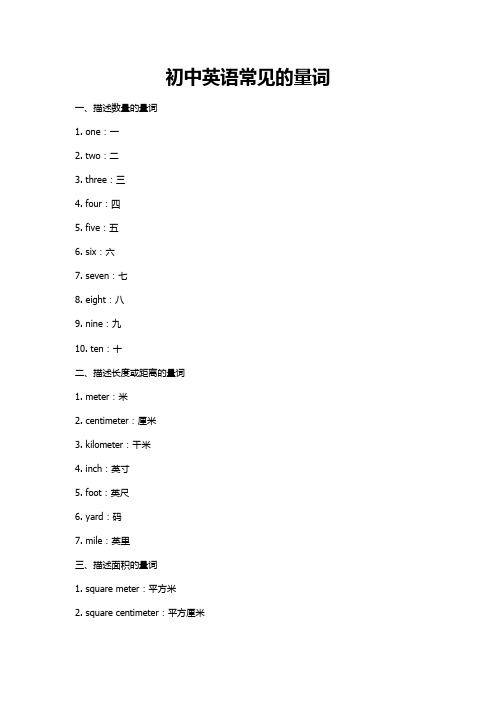
初中英语常见的量词
一、描述数量的量词
1. one:一
2. two:二
3. three:三
4. four:四
5. five:五
6. six:六
7. seven:七
8. eight:八
9. nine:九
10. ten:十
二、描述长度或距离的量词
1. meter:米
2. centimeter:厘米
3. kilometer:千米
4. inch:英寸
5. foot:英尺
6. yard:码
7. mile:英里
三、描述面积的量词
1. square meter:平方米
2. square centimeter:平方厘米
3. square kilometer:平方千米
4. square inch:平方英寸
5. square foot:平方英尺
6. square mile:平方英里
四、描述体积或容积的量词
1. cubic meter:立方米
2. cubic centimeter/litre:立方厘米/升
3. cubic kilometer:立方千米
4. cubic inch/gallon:立方英寸/加仑
5. cubic foot/gallon:立方英尺/加仑
6. cubic mile/gallon:立方英里/加仑
五、描述重量或力度的量词
1. gram:克
2. kilogram:千克
3. tonne:公吨
4. pound:磅
5. ounce:盎司。
英语常用量词

英语常用量词
以下是一些英语常用的量词:
1. A/an: 一个(用于不可数名词和单数可数名词)
例如:a book(一本书), an apple(一个苹果)
2. Some: 一些、一些的、若干
例如:some water(一些水), some friends(一些朋友)
3. Few: 几个、少数的
例如:a few coins(几个硬币), a few people(几个人)
4. Many: 许多、很多的
例如:many books(许多书), many students(很多学生)
5. Several: 几个、一些
例如:several cups(几个杯子), several times(几次)
6. Each: 每一个
例如:each person(每个人), each time(每次)
7. Every: 每个
例如:every day(每天), every student(每个学生)
8. All: 所有的、全部的
例如:all students(所有的学生), all the books(全部的书)
9. Any: 任何、一些
例如:any questions(任何问题), any time(一些时间)
10. None: 没有的、没有一个的
例如:none of the books(没有一本书), none of the students (没有一个学生)
以上是一些常用的英语量词,希望对你有帮助!。
初中英语量词知识点

初中英语量词知识点量词:通常用来表示人、事物或动作的数量单位的词,叫做量词。
例如:a bag of (rice), a piece of (news), a cup of (tea)量词特点:在英语中,有很多量词词组,例如:a group of,a flock of, a bunch of,a bundle of等等.量词词组粗略地归纳了以下的特点,具体表现为:特点一:英语量词词组所表示的数或量,大致可归纳为四种类型,即定量、不定量、大量和少量。
1.表示定量的量词词组,譬如:a couple of(两个、一对)a couple of days,a couple of players,a couple of times;a cupful of(一满杯)a cupful of jelly,a cupful of water;a portion of(一份/客)a portion of duck,a portion of roast beef。
2.表示不定量的量词词组,譬如:a majority of(大多数/大半)a majority of opinions,a majority of votes;an atom of(一点)an atom of food,an atom of truth;a spell of(一阵/一段时间)a spell of fine weather,a spell of coughing。
3.表示大量的量词词组,譬如:a flood of?a flood of ink(洋洋大篇),a flood of tears(泪如泉涌);a heap of?a heap of earth(一堆泥土),a heap of customers(许多顾客);a mountain of?a mountain of debts(债台高筑),a mountain of difficulties(困难重重)。
英语中的量词
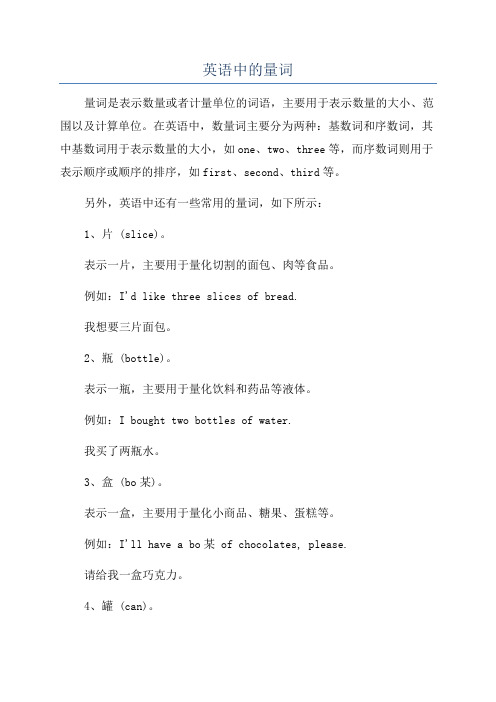
英语中的量词量词是表示数量或者计量单位的词语,主要用于表示数量的大小、范围以及计算单位。
在英语中,数量词主要分为两种:基数词和序数词,其中基数词用于表示数量的大小,如one、two、three等,而序数词则用于表示顺序或顺序的排序,如first、second、third等。
另外,英语中还有一些常用的量词,如下所示:1、片 (slice)。
表示一片,主要用于量化切割的面包、肉等食品。
例如:I'd like three slices of bread.我想要三片面包。
2、瓶 (bottle)。
表示一瓶,主要用于量化饮料和药品等液体。
例如:I bought two bottles of water.我买了两瓶水。
3、盒 (bo某)。
表示一盒,主要用于量化小商品、糖果、蛋糕等。
例如:I'll have a bo某 of chocolates, please.请给我一盒巧克力。
4、罐 (can)。
表示一罐,主要用于量化罐装食品、饮料等。
例如:He drank two cans of beer last night.昨晚他喝了两罐啤酒。
5、个 (piece)。
表示一个,主要用于量化物品的个数。
例如:We need four pieces of paper for the project.项目需要四张纸。
6、条 (bar)。
表示一条,主要用于量化巧克力、棒棒糖、鱼等。
例如:She ate a bar of chocolate after dinner.她晚餐后吃了一根巧克力。
7、件 (piece)。
表示一件,主要用于量化衣物、家具、器具等。
例如:She bought a new piece of furniture for her house.她为自己的房子买了一件新的家具。
8、辆 (vehicle)。
表示一辆,主要用于量化交通工具。
例如:I'll buy a new car ne某t year.明年我会买一辆新车。
- 1、下载文档前请自行甄别文档内容的完整性,平台不提供额外的编辑、内容补充、找答案等附加服务。
- 2、"仅部分预览"的文档,不可在线预览部分如存在完整性等问题,可反馈申请退款(可完整预览的文档不适用该条件!)。
- 3、如文档侵犯您的权益,请联系客服反馈,我们会尽快为您处理(人工客服工作时间:9:00-18:30)。
英语量词用法大全
场景1:当和外国友人走在公园,突然看到一群鸽子。
这时候你是不是就会说:There are many pigeons 或者a lot of呢?想再高大上一点吗?Sam, look! There is a flock of pigeons over there.
场景2:当说三张纸的时候,是不是很习惯说:“three papers”?错了哦。
paper是不可数名词。
正确说法是:three pieces of paper。
◆◆量词用法整理+讲解◆◆
量词可以用于描述可数名词比如a herd of elephants(一群大象), 也可以描述不可数名词;比如three pieces of paper(三张纸).
1、描述一群...量词+群+of+名词
一群人a/an crowd/group/army/team/of people;
一群牛、象、马、天鹅a herd of cattle/elephants/horses/swans
一群鸟、鹅、母鸡、羊、燕子a flock of birds/geese/hens/goats/swallows
一群猎狗、狼a pack of hounds/wolves
2、描述一丝/点/层
一丝怀疑a shadow of doubt
一线未来之光a glimpse of future
一缕月光a streak of moonlight
一层霜/雪/糖霜a layer of frost/snow/cream
3.piece块;片;段;项;件;篇;首;幅;张a piece of bread/paper/wood/furniture/land/advice/news/meat/cloth/mu sic...
4、英译“一阵”
一阵哭泣/喝彩/炮击/雷声a burst of tears/cheers/gunfire/thunder 一阵泪雨/瓢泼大雨/夸夸其谈a flood of tears/rain/boasts
5. A pair of 在英语需要成双成对的表达:
a pair of glasses (一副眼镜)
a pair of scissors (一把剪刀)
a pair of spectacles (一副眼镜)
a pair of trousers (一条裤子)
a pair of pants (一条裤子)
a pair of pliers(一把剪钳)
6、最常用英语量词用法例举a drop of water 一滴水
a flood of moonlight 一片月光
a streak of moonlight一缕月光
a flood of light 一大片强光
a streak of light 一缕光
a flood of people人潮如涌
a flood of words口若悬河
a flood of tears泪如泉涌
a wisp of smoke 一缕烟/一股烟
a wisp of a smile 一丝微笑
a pane of glass 一块玻璃
a layer of rock 一层岩石
a cloud of smoke 一团烟雾
a beam of light 一束光线
a blade of grass 一片草叶
a block of wood 一块木头
a cube of sugar 一块方糖
a roll of newspaper 一卷报纸
a cone of ice-cream 一个蛋卷冰淇淋a bar of chocolate 一块巧克力
a stack of hay 一堆乾草
a loaf of bread 一个面包
a grain of rice 一粒米
a cake of soap 一块肥皂
a dash of salt 一撮盐
a coil of wire 一卷电线
a roll of tobacco一卷烟草
a roll of bread 一块面包
a ball of wool 一个毛线球
a glimmer of hope 一线希望
a thread of hope一线希望
a thread of smoke一缕青烟
a piece of such cord一根细丝
a thread of water细细的一条流水
a mouthful of sweet country air一口新鲜的乡村空气
a handful of corn 一把玉米
a handful of people 少数几个人
a group of people [trees, houses]一群人[一片树林, 一片房子] an army of elephants 一群大象
a pack / throng of wolves 一群狼
a batch of dogs 一群狗
a brood of chicks 一群小鸡
a hive of bees 一群蜜蜂
a host of monkeys 一群猴子
a school of fish 一群鱼
a swarm of locusts 一群蝗虫
a team / field of horses一群马
a gang of elks 一群驼鹿
a burst of laughter 一阵笑声
a gust of wind 一股风
a we
b of railroad 铁路网
a train of thoughts 一连串的想法
a nice cup of tea 一杯好茶
a thin coat of ice 一层薄冰
a stagnant pool of water 一潭死水
a beautiful stretch of field 一片美丽原野a pair of glasses 一副眼镜
a pair of scissors 一把剪刀
a pair of pliers一把钳子
a pair of spectacles 一副眼镜
a pair of trousers 一条裤子
a pair of shoes一双鞋
a pair of pant 一条裤子
a pair of dancers一对舞伴
a pair of stairs一段楼梯
a pair of pliers 一把剪钳
a piece of paper 一张纸
a piece of information 一条消息
an article of clothes 一件衣物
a cup of water 一杯水
a packet of cigarettes 一盒香烟
a basket of vegetables 一篮子蔬菜。
